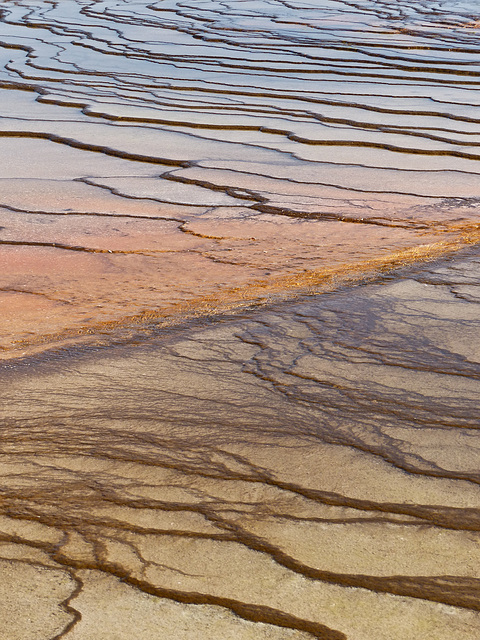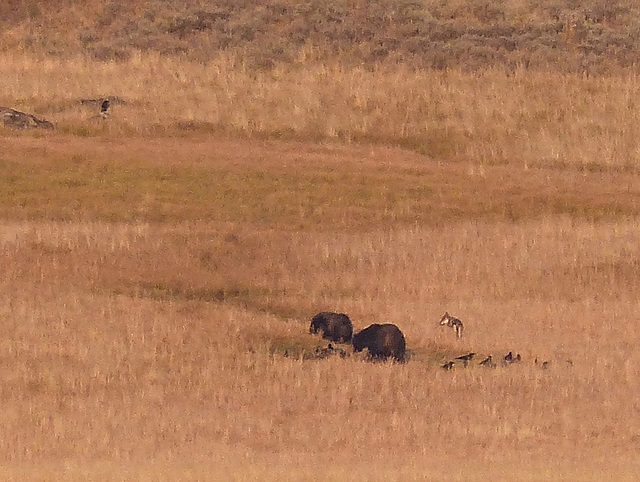
Yellowstone National Park & Grand Tetons
14 Sep 2012
1 favorite
Common Raven
A Common Raven that was hanging around one of the parking lots along the Grand Canyon of the Yellowstone River (North Rim?), no doubt hoping to find some easy food. It hopped just a little too close in this photo - I did not intend cutting off the beak : ) Taken on 14 September 2012, during a week's holiday down as far as Yellowstone National Park and the Grand Tetons.
"Common Ravens will eat almost anything they can get hold of. They eat carrion; small animals from the size of mice and baby tortoises up to adult Rock Pigeons and nestling Great Blue Herons; eggs; grasshoppers, beetles, scorpions, and other arthropods; fish; wolf and sled-dog dung; grains, buds, and berries; pet food; and many types of human food including unattended picnic items and garbage."
www.allaboutbirds.org/guide/common_raven/lifehistory
en.wikipedia.org/wiki/Common_Raven
Say "Cheese"!
This female Elk had just swum across the water from a narrow island just offshore at Yellowstone Lake, Wyoming, US. Several Elk seem to like to rest on this narrow strip of land and it looks so beautiful to see them and their reflections in the lake. Taken on 13 September 2012.
John Moulton Ranch, Mormon Row, Grand Teton National Park, Wyoming
Having seen so many spectacular photos of this and another barn from the Mormon Row Historic District, I was thrilled to bits that my friends from England, Linda and Tony, drove to this wonderful spot. I was not so thrilled to see that the sun was in exactly the wrong spot, ha. Still, it was great to see these wonderful old barns that have such a great range of mountain peaks (Grand Tetons) behind them. Wild Bison were hanging around some of the buildings, which made for a somewhat uneasy walk. We also saw a little Mountain Bluebird in the trees there. Couldn't believe that the other beautiful barn, that I so much wanted to photograph, had a wedding party going on, with a bus parked nearby and people all over the place, including in front of the barn and at the side of it. I still tried, but felt very much an intruder! (Location on map is only very approximate).
en.wikipedia.org/wiki/Mormon_Row_Historic_District
14 Sep 2012
Pronghorn
We saw a number of these beautiful Pronghorns during my recent week away with friends down to Yellowstone National Park and Grand Teton National Park. We do get these way east and south of Calgary, but I've only ever seen them once or twice. Photographed in Yellowstone National Park on 14 September 2012.
"Though not an antelope, it is often known colloquially in North America as the prong buck, pronghorn antelope, or simply antelope."
en.wikipedia.org/wiki/Pronghorn
animals.nationalgeographic.com/animals/mammals/antelope/
Grand Prismatic Spring, Yellowstone National Park
This is such an amazing hot spring, photographed on 13 September 2012, during my recent week's trip with friends down to Yellowstone National Park and Grand Teton National Park. This photo was taken from the boardwalk, but there is also a hill you can climb to get a higher view over the whole spring - we ran out of time to do this : )
"The Grand Prismatic Spring in Yellowstone National Park is the largest hot spring in the United States, and the third largest in the world, after Frying Pan Lake in New Zealand and Boiling Lake in Dominica. It is located in the Midway Geyser Basin.
Grand Prismatic Spring was noted by geologists working in the Hayden Geological Survey of 1871, and named by them for its striking coloration. Its colors include blue, green, yellow, orange, red and brown, and recall the rainbow disperson of white light by an optical prism.
The vivid colors in the spring are the result of pigmented bacteria in the microbial mats that grow around the edges of the mineral-rich water. The bacteria produce colors ranging from green to red; the amount of color in the microbial mats depends on the ratio of chlorophyll to carotenoids and on the temperature of the water which favors one bacterium over another. In the summer, the mats tend to be orange and red, whereas in the winter the mats are usually dark green. The center of the pool is sterile due to extreme heat.... The spring is approximately 250 by 300 feet (80 by 90 m) in size and is 160 feet (50 m) deep. The spring discharges an estimated 560 US gallons (2,100 L) of 160 °F (70 °C) water per minute." From Wikipedia.
en.wikipedia.org/wiki/Grand_Prismatic_Spring
Grand Prismatic Spring, Yellowstone National Park, Wyoming
Another view taken at Grand Prismatic Spring. This is such an amazing hot spring, photographed on 13 September 2012, during my recent week's trip with friends down to Yellowstone National Park and Grand Teton National Park. This photo was taken from the boardwalk, but there is also a hill you can climb to get a higher view over the whole spring - we ran out of time to do this : )
"The Grand Prismatic Spring in Yellowstone National Park is the largest hot spring in the United States, and the third largest in the world, after Frying Pan Lake in New Zealand and Boiling Lake in Dominica. It is located in the Midway Geyser Basin.
Grand Prismatic Spring was noted by geologists working in the Hayden Geological Survey of 1871, and named by them for its striking coloration. Its colors include blue, green, yellow, orange, red and brown, and recall the rainbow disperson of white light by an optical prism.
The vivid colors in the spring are the result of pigmented bacteria in the microbial mats that grow around the edges of the mineral-rich water. The bacteria produce colors ranging from green to red; the amount of color in the microbial mats depends on the ratio of chlorophyll to carotenoids and on the temperature of the water which favors one bacterium over another. In the summer, the mats tend to be orange and red, whereas in the winter the mats are usually dark green. The center of the pool is sterile due to extreme heat.... The spring is approximately 250 by 300 feet (80 by 90 m) in size and is 160 feet (50 m) deep. The spring discharges an estimated 560 US gallons (2,100 L) of 160 °F (70 °C) water per minute." From Wikipedia.
en.wikipedia.org/wiki/Grand_Prismatic_Spring
Two Grizzlies AND a Wolf
What are the chances of seeing two Grizzly Bears feeding on the carcass of a Bison AND having a Wolf try and inch its way closer and closer to get a taste for itself? Several Ravens joined in the fun, too. Unfortunately, all this took place the far side of a valley on a very distant hillside, so full zoom and very heavy cropping were needed. Really bad quality, but I just had to post it : ) Taken in Yellowstone National Park, Wyoming, US, on 13 September 2012 - I've always said that the number 13 is my lucky number!
"At the end of 2011, at least 98 wolves in 10 packs plus 2 loners occupied Yellowstone National Park. The population size (97 wolves) and number of breeding pairs (8) is the same as at the end of 2010."
www.nps.gov/yell/naturescience/wolves.htm
Opal Pool, Midway Geyser Basin, Yellowstone National Park
On day three of my wonderful week's trip down to Yellowstone National Park and Grand Teton National Park with special friends from England, Linda and Tony (explanation is in my "US holiday, September 2012" set), we visited Midway Geyser Basin, along the Firehole River. Photographed on 13 September, Yellowstone. Grand Prismatic Spring, Excelsior Geyser Crater and Turquoise Pool are also at this Basin.
"Opal Pool is a hot spring in the Midway Geyser Basin of Yellowstone National Park, Wyoming. Opal Pool usually has a temperature of approximately 132 °F (56 °C). Though usually active as a hot spring, Opal Pool is considered a fountain-type geyser.
The first recorded eruption of Opal Pool was in 1947, recurring in 1949, 1952 and 1953, then ceasing. Eruptions resumed in 1979, happening at least once in most following years. Eruption heights are typically under 30 feet (9.1 m) in height, but some eruptions have been seen with heights of 70 feet (21 m) to 80 feet (24 m). Eruptions occur suddenly following visible convection in the pool, but are unpredictable. The eruption consists of one, huge, burst that throws water 20-80 feet high, making Opal Pool the largest active geyser at Midway Geyser Basin. Much smaller splashes seconds apart stretch the total duration to about 1 minute. Sometime in 2005 Opal completely drained, but it refilled as a beautiful green pool in 2008." From Wikipedia.
www.everytrail.com/guide/midway-geyser-basin-yellowstone-...
14 Sep 2012
Pronghorns, Yellowstone National Park
We saw a number of these beautiful Pronghorns during my recent week away with friends down to Yellowstone National Park and Grand Teton National Park. We do get these way east and south of Calgary, but I've only ever seen them once or twice. Photographed in Yellowstone National Park on 14 September 2012.
"Though not an antelope, it is often known colloquially in North America as the prong buck, pronghorn antelope, or simply antelope."
en.wikipedia.org/wiki/Pronghorn
animals.nationalgeographic.com/animals/mammals/antelope/
Jump to top
RSS feed- Latest items - Subscribe to the latest items added to this album
- ipernity © 2007-2024
- Help & Contact
|
Club news
|
About ipernity
|
History |
ipernity Club & Prices |
Guide of good conduct
Donate | Group guidelines | Privacy policy | Terms of use | Statutes | In memoria -
Facebook
Twitter










